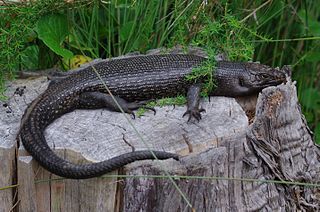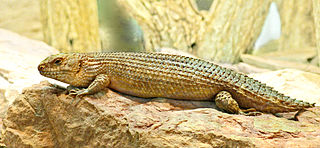
Cunningham's spiny-tailed skink, also known commonly as Cunningham's skink, is a species of large skink, a lizard in the family Scincidae. The species is native to southeastern Australia.

King's skink is a species of skink, a lizard in the family Scincidae. The species is endemic to Australia.
The great desert skink, also known as Kintore's egernia and by various names including tjakura in various Aboriginal Australian languages, is a species of skink, a lizard in the family Scincidae. The species is endemic to the western half of Australia. It is a burrowing lizard and extremely social.

White's skink, also known commonly as White's rock skink, is a species of lizard in the family Scincidae. The species is endemic to Australia.

The yakka skink is a species of large skink, a lizard in the family Scincidae. The species is native to the Brigalow Belt in Queensland in eastern Australia.
The Western Pilbara spiny-tailed skink is a species of large skink, a lizard in the family Scincidae. The species is native to the Pilbara in northwestern Australia.

The pygmy spiny-tailed skink is a species of skink, a lizard in the family Scincidae.

Egernia stokesii is a gregarious species of lizard of the Scincidae family. This diurnal species is endemic to Australia, and is also known as the Gidgee skink, spiny-tailed skink, Stokes's skink and Stokes's egernia. The species forms stable, long-term social aggregations, much like the social groups seen in mammalian and avian species. This characteristic is rarely found in the Squamata order, but is widespread within the Australian subfamily of Egerniinae skinks. Populations of E. stokesii are widely distributed, but fragmented, and occur in semi-arid environments. There are three recognised subspecies. The conservation status for the species is listed as least concern, however, one subspecies is listed as endangered.

The tree-crevice skink or tree skink (Egernia striolata) is a species of skink, a lizard in the family Scincidae. The species is endemic to Australia and is found in the states of Victoria, the Northern Territory, Queensland, New South Wales and South Australia. E. striolata tend to live in crevices and cracks in hollow logs or rocks. They greatly prefer heterogeneous and structurally diverse habitats and their behavior changes depending on the habitat they live in.

Hosmer's spiny-tailed skink or Hosmer's skink is a species of large skink, a lizard in the family Scincidae. The species is a diurnal, rock-dwelling species native to Northern Australia.
Egernia douglasi, also known commonly as the Kimberley crevice-skink, is a species of lizard in the family Scincidae. The species is endemic to Australia.
The central pygmy spiny-tailed skink is a species of large skink, a lizard in the family Scincidae. The species is native to western Australia.
Goldfield's crevice-skink is a species of large skink, a lizard in the family Scincidae. The species is native to western Australia.
The eastern crevice-skink is a species of large skink, a lizard in the family Scincidae. The species is native to eastern Australia.

The southwestern crevice-skink is a species of large skink, a lizard in the family Scincidae. The species is native to western Australia.

The Pilbara crevice-skink is a species of large skink, a lizard in the family Scincidae. The species is native to western Australia.
The bright crevice-skink is a species of large skink, a lizard in the family Scincidae. The species is native to South Australia and Western Australia.

The desert egernia, unadorned desert-skink or desert skink is a species of skink, a lizard in the family Scincidae. The desert egernia is endemic to the continent of Australia, and is widespread, with populations recorded in all mainland states and territories except the Australian Capital Territory. The desert egernia is found in dry, desert areas with deep, uncompacted sandy/loamy soils and little significant vegetation cover.
Slater's desert skink, also known commonly as the Centralian Floodplains desert-skink, Slater's egernia, and Slater's skink, is a species of lizard in the family Scincidae. The species is endemic to Australia. There are two recognized subspecies.
The night skink, nocturnal desert-skink or striated egernia is a species of skink, a lizard in the family Scincidae. The species is endemic to western Australia.











